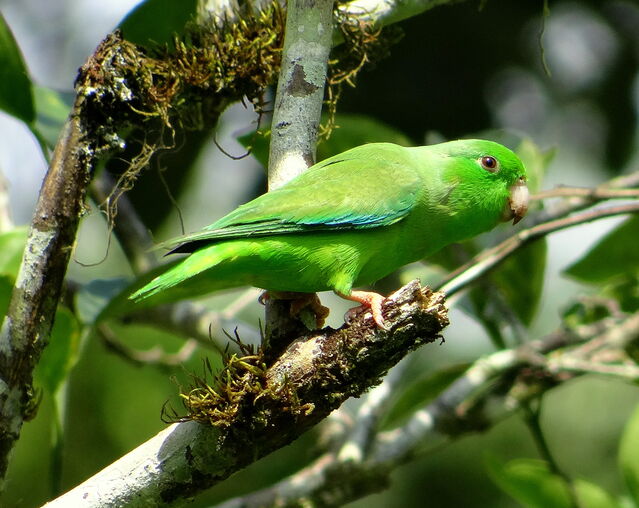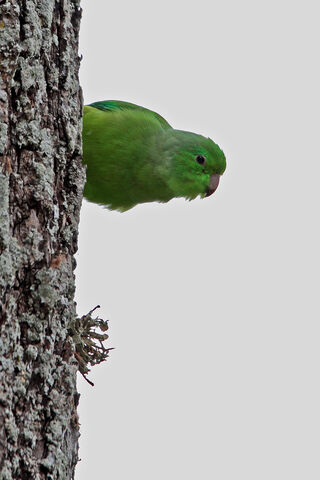Hormones
Baby Parrots Babble Like Human Infants
Parrots may be an apt model for the development of language in humans.
Posted June 14, 2022 Reviewed by Abigail Fagan
Key points
- Researchers documented vocal babbling in wild parrot chicks using audio-video recordings inside specially designed nest cavities.
- Both male and female parrots babbled, with the behavior emerging very early in development.
- Baby parrots engaged in quiet babbling either alone or in the presence of siblings and produced a diverse medley of adult and nestling sounds.
- Corticosterone treatment led to increased vocal repertoires, indicating that babbling in parrots is modulated by stress hormones.

In a new study, researchers report that baby parrots in the wild quietly babble to themselves in their nests. The finding adds parrots to the small group of animals whose young go through a babbling stage similar to human infants.
Vocal babbling has been reported in a handful of nonhuman species, including sac-winged bats and pygmy marmosets, but it is most studied and best understood in songbirds. Songbird babbling, however, differs from human babbling in important ways. In songbirds, only males babble and it coincides with their puberty phase, indicating that the behavior is modulated by sex hormones. Could an animal other than a songbird be a better model of how humans learn language?
Like humans and other animals that babble, parrots are vocal learners, meaning they learn their vocalizations by listening and mimicking what they hear. In contrast to songbirds, both male and female parrots begin producing calls during the nestling phase, well before they reach sexual maturity. Despite their well-known vocal learning abilities, however, a babbling phase had never been reported in parrots.
Karl Berg, a behavioral ecologist at the University of Texas Rio Grande Valley and one of the authors of the new study, says that babbling in parrots may have gone unnoticed due to the birds’ nesting behavior: Parrots are cavity-nesters, raising their young hidden away in sheltered chambers like tree holes.

Berg and colleagues’ discovery was enabled by a unique long-term field study. The team worked with a population of green-rumped parrotlets at Masaguaral Biological Station in Venezuela. These birds are part of the longest ongoing study of any wild parrot population — over 10,000 individuals have been fitted with identifying bands since the study began in 1988.
“These birds are the size and color of a leaf,” says Berg. “But today when you walk through the study site, you can take out your telescope and identify individuals by their bands and look up their identities, their ages, and their relatives.”
Berg says that part of the success of the long-term study is due to more than 100 PVC pipes acting as artificial nest cavities. Researchers have installed audio and video recorders inside the nest cavities that allow them to monitor what goes on within.
Babbling Baby Birds
Recordings from inside green-rumped parrotlet nests revealed another possible reason why babbling had not been seen previously — baby parrots tend to babble when no adults are around, and they do it quietly.
The researchers found that babbling begins around 21 days of age in both male and female parrotlets. The sounds they make, including soft peeps, clicks, and grrs, aren’t directed at their siblings or parents. Indeed, chicks often babble when alone or when their siblings are asleep.
Berg and his colleagues analyzed the babbling bouts and identified 27 distinct calls, including mixtures of begging, alarm, and contact calls and other sounds the chicks hear from their parents and siblings.

The researchers also investigated whether parrot babbling resembled human babbling in terms of the crucial hormones involved. Previous research has found that in humans, it’s stress hormones that play a role in infant language development. This differs from the process of song learning in songbirds, which is supported by sex hormones.
Babbling in human babies usually begins around six months, the same time that the endocrine system starts producing stress hormones, says Berg.
“The endocrine system helps internalize environmental information,” he says. “That’s important for a lot of things in life and learning is one of them.”
To find out whether stress hormones modulate parrotlet babbling, the researchers fed chicks small amounts of the stress hormone corticosterone during the first week of babbling. After treatment with the stress hormone, chicks of both sexes had increased vocal repertoires, making twice as many unique babbling noises as chicks that did not receive any stress hormones. Berg and his colleagues conclude that stress hormones at an early age have organizational effects on brain development in parrots.
Parrot Appreciation
Berg is continuing to examine the relationship between stress and babbling by introducing the hormones at different stages in the chicks’ development. Although he still has questions about when during development stress hormones are most important, Berg says he hopes that parrots can provide insights into endocrine system feedback during language learning in infants.
“Just knowing that another lineage has this ability gives us a broader evolutionary perspective on why different species babble the way they do,” says Berg.
Finally, Berg says he hopes this study contributes to our understanding of the complexity of parrots’ lives in the wild. He points out that there are over 400 parrot species and they are among the most threatened of birds.
“It’s important to raise consciousness about how these animals go through a stage similar to human infants en route to their adulthood,” says Berg. “I feel privileged to get a window into their social lives and to witness the complexity.”
References
Eggleston R, Viloria N, Delgado S, Mata A, Guerrero HY, Kline RJ, Beissinger SR, Berg KS. Vocal babbling in a wild parrot shows life history and endocrine affinities with human infants. Proc Biol Sci. 2022 Jun 8;289(1976):20220592. doi: 10.1098/rspb.2022.0592. Epub 2022 Jun 1.




